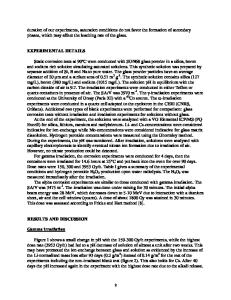The Effect of Gamma Radiation on the Dissolution of High-Level Waste Glass in Boom Clay
- PDF / 156,389 Bytes
- 9 Pages / 612 x 792 pts (letter) Page_size
- 26 Downloads / 302 Views
The Effect of Gamma Radiation on the Dissolution of High-Level Waste Glass in Boom Clay K. Lemmens and P. Van Iseghem Waste and Disposal Department, SCK•CEN, Boeretang 200 B-2400 Mol, Belgium Email: [email protected] ABSTRACT The effect of γ-radiation on the dissolution of candidate high-level waste glasses was investigated in potential disposal environments at 90°C. The media consisted of mixtures of Boom Clay, bentonite clay and cement with clay water. During the experiments the pH of Boom Clay decreased, probably mainly by radiolytical oxidation of pyrite. The addition of bentonite, cement and glass buffered the pH decrease. Under radiation the glass mass losses decreased, whereas the leach rate of soluble elements was not influenced or appeared to increase. This is explained through the radiolytical acidification, and possibly by bubble formation in the glass. INTRODUCTION Belgium is focusing its R&D on geological disposal of vitrified high-level waste through demonstration of the suitability of a Boom clay layer, situated below the SCK•CEN site. Laboratory studies are being carried out to investigate the compatibility of the candidate HLW glasses with the potential disposal environments. In the first 500 years, the gamma activity and the temperature of the glass canisters will be high due to the decay of the fission products. During this thermal phase the overpack surrounding the glass canisters should prevent the contact between the glass and its near field. The present study was conceived to evaluate the effect of the γ-radiation field on the interaction between the HLW glass and various candidate near field materials. This study thus considers the accidental situation of an early failure of the overpack. EXPERIMENT The corrosion tests under γ-irradiation were performed in the RITA facility of SCK•CEN. A container loaded with platina corrosion cells was positioned in between 60Co sources, and heated at 90°C for 14, 90 and 180 days. The target dose rate was 600 Gy/h, this is the dose rate at the surface of a Cogéma SON68 canister after less than 50 years of cooling. Because the experimental program was spread over several years (from 1993 to 1999), the 60Co decay, with the intermediate renewal of the γ-sources, caused a variation of the actual dose rate. Hence, the dose rate varied between 360 and 650 Gy/h (for some tests of 14 days, the dose rate was even less, i.e. about 200 Gy/h). The corrosion cells were loaded with different kinds of interaction materials, described below :
• a slurry of 500 g of (wet) Boom Clay and 25 g of metallic corrosion products (Fe2O3, designated as "CP") per liter Boom Clay water. This represents the Boom Clay host formation. This mixture is designated as "BC+CP", or "BC", when the Fe2O3 is omitted. • slurries of Boom clay, metallic corrosion products and candidate backfill materials (bentonite clay and cement), mixed with Boom Clay water. This situation represents potential near field environments. For the bentonite containing slurry, 220 g of (wet) Boom Clay, 220 g of (dry) F
Data Loading...











